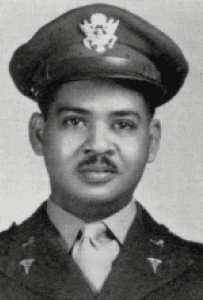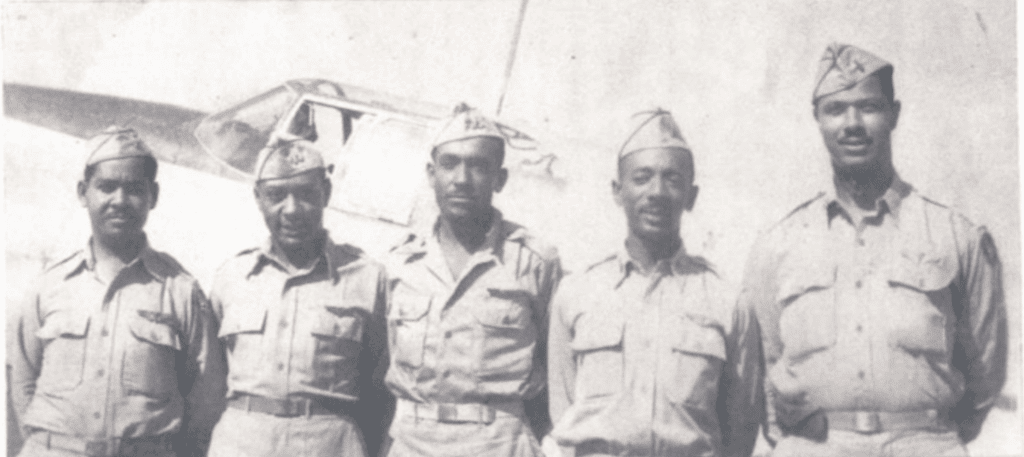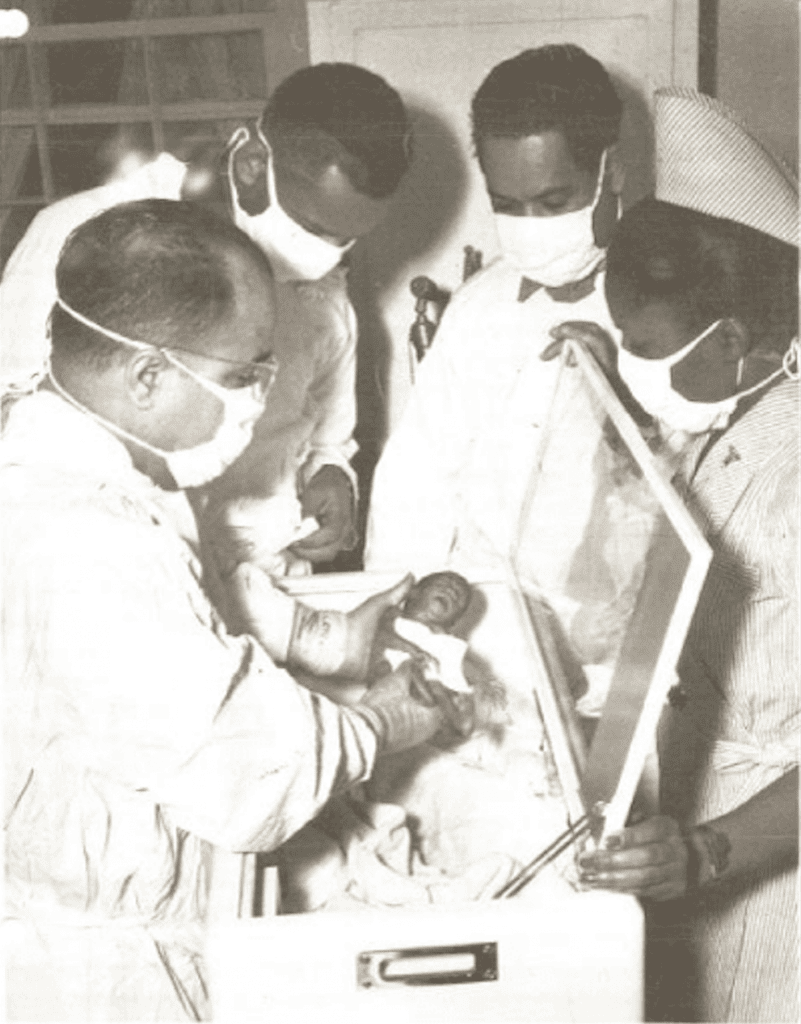 Dr. Vance H. Marchbanks, Jr
Dr. Vance H. Marchbanks, Jr
January 12, 1905 – October 21, 1988
The movie “Hidden Figures” was about three African American women who were very instrumental in America’s first space flight by astronaut John Glen. Often forgotten, and unrecognized is the tremendous contribution of Dr. Vance Marchbanks, Jr, United States colonel who was equally significant contributor to the success of Glen’s historic flight. Dr. Marchbanks was a pioneering flight surgeon who medically monitored Glen during his flight.
Beginning in his early childhood years, Vance Hunter Marchbanks, Jr., displayed a profound interest in medicine. After undergoing an operation himself at 10, he cultivated a friendship with the surgeon. Their favorite pastime, was to go out into the back yard and “operate” on cherries. He would cut them open, take out the seeds, and sew them up again.
Marchbanks was born January 12, 1905 at Ft. Washakie, Wyoming where his father, Vance Sr., a U. S. Army Calvary veteran (i.e., 20th Century “Buffalo Soldier”) was stationed. His early years were spent at Fort Huachuca in Arizona, the military post from which his father would later retire as a commissioned officer. In 1929, while in his sophomore year at the University of Arizona in Tucson, Marchbanks received a West Point appointment from President Calvin Coolidge. He was, however turned down because he did not have the proper academic credits. Despite this rejection, he continued to pursue his pre-medical curriculum while working as a postal employee. During his tenure as an undergrad at the University of Arizona, he was not permitted to live in a dormitory. Marchbanks was forced to live in a boarding house off campus because of his color, the only place he was permitted to eat at was a local railroad station where he often found cockroaches had been placed in his food.
Undaunted, Marchbanks pursued his dream of becoming a doctor by enrolling in Medical School at Howard University. His father was desperate to help him with expenses, but had very limited resources himself. Fortunately, Marchbanks, Sr. was assigned to the Washington High School Cadet Corps in Washington, DC from 1934 to 1939, so Marchbanks, Jr. was able to live at home, thus reducing his medical school expenses considerably. He graduated in 1937 and continued on to complete his residency there at Howard.

Maj. (Dr.) Vance H. Marchbanks Jr. in Italy, 1944
Inducted into the army as a First Lieutenant in 1941, Marchbanks was assigned to the U.S. Veterans Administration Hospital (colored) in Tuskegee, Alabama. He wanted to complete the aviation medicine course at Randolph Field, Texas, but was transferred to Ft. Bragg, North Carolina, where he suffered “many unpleasant experiences.” Finally in June 1942, Marchbanks was assigned to the Station Hospital at Tuskegee Army Air Field, then to Selfridge Field as a flight surgeon with the 302nd Fighter Squadron. He finally obtained his rating as an aviation medical examiner through the extension course at the School of Aviation Medicine. Marchbanks deployed overseas with the 332nd Fighter Group. “Upon arrival in Italy, all the aviation medical officers became flight surgeons,” he said. 4 Marchbanks went on to become the group surgeon of the 477th Composite Group, then director of the hospital at Lockbourne Army Air Base near Columbus, Ohio, the only Army base managed by Negro personnel.
Following his promotion to rank of Major, Dr. Marchbanks was one of the first of the Group’s flight surgeons to centralize medical support under one US Army Air Corps organization. He in conjunction with his staff treated everything from frostbite and ear infections, to “air-sickness in pilots operating in poorly heated, high-altitude cockpits, as well as combat casualties and routine sick calls at the main camps.
When the Air Force was established and racial desegregation began in 1949, Lockbourne was disbanded. Marchbanks was assigned to March Air Force Base in California, where he was group surgeon of the 1st Fighter Group, then of the 22nd Bombardment Group, which was subsequently transferred to Okinawa. In January 1951, Marchbanks was back at Lockbourne Air Base as wing surgeon of the 91st Strategic Reconnaissance Wing. Then it was back to the Far East as Deputy Commander and chief of the professional service at the Air Force Hospital at Nagoya, Japan. In March 1955, Marchbanks was promoted to full colonel and he became Air Force surgeon of Okinawa later that same year. His next assignment took him to Loring Air Force Base, Maine, where he was hospital commander and division surgeon.

During his career, Marchbanks received two AF Commendation Medals for his research work. He “developed requirements for standardization of an oxygen mask tester (MO-1),” which became a standard piece of AF equipment. In Operation Long Legs, Marchbanks flew some 22 hours non-stop from the U.S. to Argentina and return, conducting research on flying stress and combat fatigue. He subsequently developed stress tests and rating systems that were incorporated into AF operations. It was this research, he believed, that earned him a place as one of eleven Air Force surgeons to work on the National Aeronautics and Space Administration’s Project Mercury. Monitors were stationed around the world. From his tracking station in Kano, northern Nigeria in 1962, Marchbanks monitored John Glenn’s “electrocardiogram, respiration and heart rate” each time he flew over.

From Cora “Tess” Spooner on behalf of Dr. Marchbanks Family. 1946 at Lockbourne Army Air Base. Premature baby girl born at Lockbourne AAB Hospital. L to R: Dr. Marchbanks, Dr. Edward Cooper, Dr, Arelious King, and nurse Nancy Leftenant.
Notable among Dr. Marchbanks many research studies was the one on sickle cell disease, a painful condition that afflicts mostly people of Mediterranean and African descent. The military habitually disqualified people from pilot training, if they carried the sickle cell trait even though they did not have sickle cell disease. Marchbanks conducted a three-year study drawing blood from Tuskegee Airmen pilots who were WWII veterans. Out of 154 men, 10 carried the sickle cell trait. One of those had 600 combat flying hours. This study led the Air Force to revise its policy of prohibiting personnel from flying if they carried the sickle cell trait.
On February 20, 1962, during the epic triple orbit of the Earth by astronaut John Glenn in “Friendship 7″—Dr. Marchbanks was stationed at the Kano, tracking station in Nigeria, West Africa. If one of the “aeromedical monitor” doctors at any tracking station determined the astronaut was in dire distress, he could recommend the space flight be prematurely halted.
During Dr. Marchbanks 35 days at the African outpost, he discovered that the hygiene at the medical library was inadequate. So, typical of his concern for every community in which he lived, he volunteered his assistance. Thus, while in Africa, Dr. Marchbanks wrote medical colleagues and publishers and collected over 200 texts for the school.
In 1964, after having completed some 23 years of distinguished service, Dr. Marchbanks retired from the USAF as a Colonel and Chief Flight Surgeon. Dr. Marchbanks began his new journey as a civilian in Hartford, Connecticut as Chief of Environmental Health Services at Hamilton Standard, a division of United Aircraft Corp. Among his responsibilities, he oversaw the medical testing of the moonsuit and backpack that were eventually used in the Apollo Space missions. He left Hamilton Standard in 1970 and continued in private practice, specializing in aviation and space medicine. He served as a consultant in space medicine until 1986.
However, it was perhaps his pioneering study of sickle cell anemia that led to the inclusion of more blacks as pilots and astronauts that left an indelible mark. His friendship with the Tuskegee Airmen afforded him the opportunity to right a wrong that ended military careers and kept young men from even applying. During the 1970’s, if the military found the genetic trait for sickle cell in the blood of healthy service members they were discharged. Marchbanks took on the military’s post- WWII policy on sickle cell anemia. Sickle cell is an inherited disease, primarily affecting people of African and Mediterranean descent. In his three-year study Marchbanks drew blood from black airmen he knew during World War II. He published his findings in an essay entitled, “Sickle Cell Trait and the Black Airman.” The essay helped to convince the military that people who carried the trait did not necessarily develop the deadly anemia. The military ultimately ended its practice of discharging service members who had the trait.
On October 21, 1988, Dr. Vance Hunter Marchbanks, Jr. died at 83 years of age. His life as a devoted husband to Lois, a proud father to two daughters, Roslyn and Joy, a doting grandfather, and a friend to many in both the military and civilian life. With his passing, the world lost an esteemed American hero.
Dr. Marchbank is like the three women in the movie Hidden Figures; he played a large role in astronaut John Glen’s historic flight. They are now receiving accolades for helping to advance the United States very successful space program. His foresight and efforts were instrumental to the development of aeronautic or aviation medicine as we know it today.
Visit the Red Tail Virtual Museum to learn more about the Tuskegee Airmen Surgeons.
Sources:
ECCTAI.org
Peertechzpublications.com
The Corsicana Daily Sun (Corsicana, Texas) – June 8, 1961
Hartford Courant (Harford, Connecticut) – Aug.24, 1964
Hartford Courant (Hartford, Connecticut) – October 23, 1988
Hartford Courant (Hartford, Connecticut) – January 17, 1966
Hartford Courant (Hartford, Connecticut) – August 24, 1964
The Indianapolis Star (Indianapolis, Indiana) May 2, 1982:26; Howard University (Sickle Cell) Recognition in 1983- From the Collection of Cora “Tess” Spooner.





